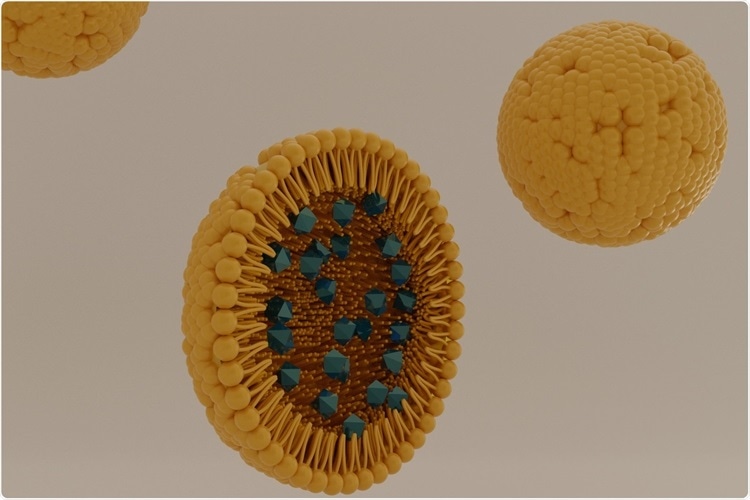Nanoparticles, materials with a size less than 100 nm, have been used widely in many applications. Their small size makes their surface to volume ratio large, which has been used advantageously. Nanoparticles have been made from a wide variety of materials, including inorganic, metals, and organic materials.
The use of nanoparticles in pharmaceutical applications has many benefits. These materials can improve drug solubility, controlled drug release, and targeting of specific cells. In addition, they show efficient adsorption of many types of biomolecules and other chemicals, and can be used both for therapy and diagnostics. In a recently published review in Current Opinion in Colloid & Interface Science, a team of researchers reviewed current nanoparticle technologies and how nanoparticles can be used to combat COVID-19.

Biomolecular interactions with nanoparticles: Applications for COVID-19.
Interaction with biomolecules
Nanoparticles can be functionalized or even made porous or hollow so biomolecules can be attached to them. Several inorganic nanoparticles have been studied for drug delivery for viral infections.
Gold nanoparticles are attractive in vaccines as they can act to increase the immune response. Silver nanoparticles have shown antiviral activity and, when employed with bronchodilators, can be used in treating COVID-19. Quantum dots are another type of nanoparticles that can be used for detection and diagnosis because of their excellent sensing properties.
Organic nanoparticles can also be used for therapeutic applications. Cyclodextrin nanoparticles have a hydrophilic outer core and a lipophilic center. Lipid nanoparticles are used in pharmaceutical compositions because of their high biocompatibility and low toxicity.
Nanoparticles can be made of a size similar to the severe acute respiratory syndrome coronavirus 2 (SARS-CoV-2). They may interact with the virus proteins and could disrupt virus replication.
Nanoparticle-based therapeutics for COVID-19
SARS-CoV-2 is an RNA virus that is primarily transmitted by airborne droplets from respiratory exhalation, coughing, or sneezing of infected persons. The spike protein of the virus and its receptor-binding domain (RBD) attach to host receptors like the human angiotensin-converting enzyme 2 (ACE2) during infection.
The spike protein and the RBD are important targets for therapeutics. Tests have shown that iron oxide nanoparticles can form a stable complex with the spike protein, so these materials that are used today for treating anemia can be repurposed to treat COVID-19. Carbon nanotubes, which have good electrical and thermal properties, can be used to develop functional materials that can heat up locally and prevent virus replication.
mRNA vaccines use mRNA encapsulated in organic nanoparticles, usually, lipid nanoparticles and two types of such vaccines have now been approved for use. Another type of RNA vaccine uses self-amplifying RNA (saRNA), which makes mRNA at a much higher concentration than the viral genome, making the viral antigen much more effective. Studies have encapsulated saRNA in lipid nanoparticles and found that they can produce high levels of neutralizing antibodies in mice.
Nanoparticles can also be used to deliver therapies in different forms. Drugs can be encapsulated in liposomes, allowing them to be eaten. Liposomes can also protect sensitive materials like mRNA. Nanoparticle systems can also be designed to be inhaled, which will be particularly useful for treating COVID-19.
Other applications
Drugs used for treating other diseases may also be repurposed to combat COVID-19. Some studies have looked at natural compounds that can be used for treating COVID-19. Chitosan nanoparticles, which have been used before against the hepatitis C virus, could potentially be used for COVID-19. These materials may likely prevent viral entry by blocking the positive charge on the host cell surface.
Nanoparticle technologies can also be used to improve the testing and diagnosis of the disease. A study found that by integrating detecting methods on a nanogold chip, the sensitivity and reliability of the sensor can be increased.
Lanthanides are another class of materials with unique properties. Lanthanide-based nanoparticles have been investigated as a biosensor in lateral flow immunoassays to detect IgG antibodies in human sera. This could be used to monitor immune response and disease progression in patients.
Thus, there are several potential applications of nanoparticles in combating COVID-19. There is a need for a global collaborative effort to find treatments and antivirals. Experimental studies coupled with computational studies that can optimize nanoparticle interactions with drugs or the virus can help develop better therapies faster.
Read the original article on News Medical.
